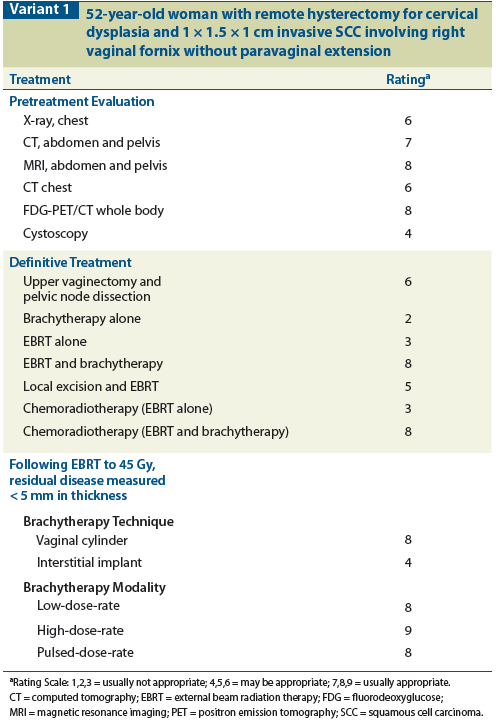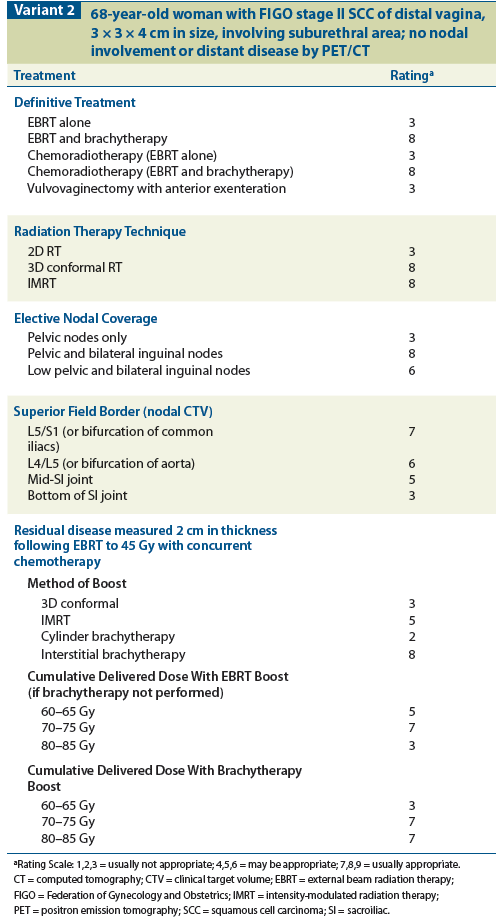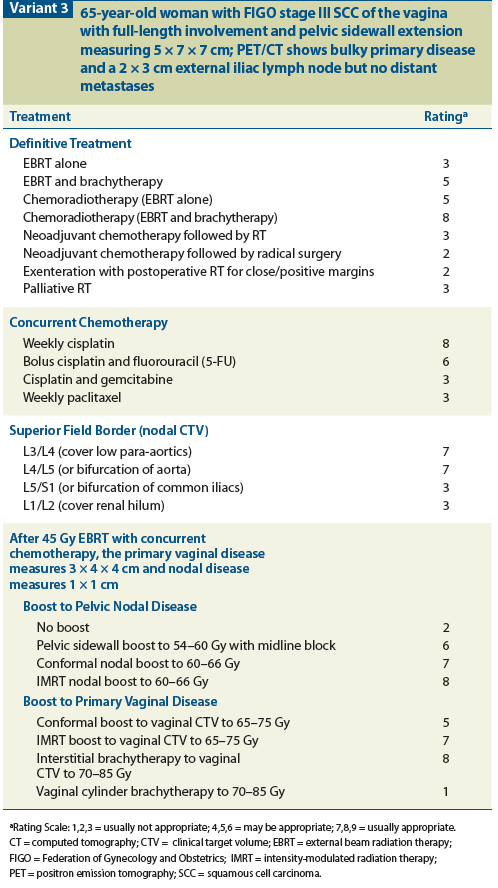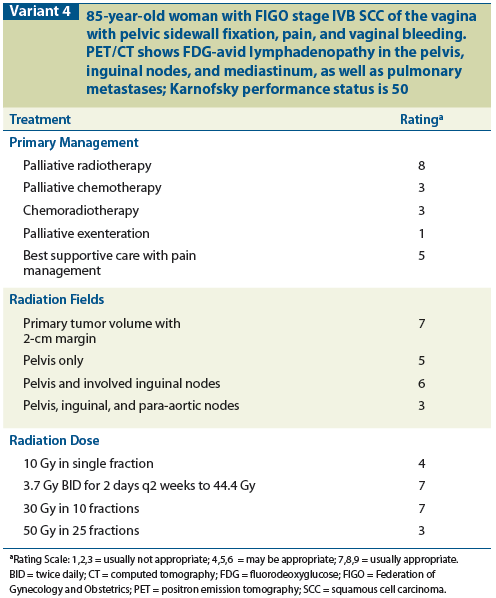ACR Appropriateness Criteria® Management of Vaginal Cancer
This article represents the consensus opinion of an expert panel and may be used to inform clinical recommendations in vaginal cancer management.
Variant 1: 52-year-old woman with remote hysterectomy for cervical dysplasia and 1 × 1.5 × 1 cm invasive SCC involving right vaginal fornix without paravaginal extension

Variant 2: 68-year-old woman with FIGO stage II SCC of distal vagina, 3 × 3 × 4 cm in size, involving suburethral area; no nodal involvement or distant disease by PET/CT

Variant 3: 65-year-old woman with FIGO stage III SCC of the vagina with full-length involvement and pelvic sidewall extension measuring 5 × 7 × 7 cm; PET/CT shows bulky primary disease and a 2 × 3 cm external iliac lymph node but no distant metastases

Variant 4: 85-year-old woman with FIGO stage IVB SCC of the vagina with pelvic sidewall fixation, pain, and vaginal bleeding. PET/CT shows FDG-avid lymphadenopathy in the pelvis, inguinal nodes, and mediastinum, as well as pulmonary metastases; Karnofsky performance status is 50

Appendix.: Summary of Definitive Radiation Therapy Series for Vaginal Cancer

Due to its rarity, treatment guidelines for vaginal cancer are extrapolated from institutional reports and prospective studies of cervical and anal cancer. An expert panel was convened to reach consensus on the selection of imaging and therapeutic modalities. The American College of Radiology Appropriateness Criteria are evidence-based guidelines for specific clinical conditions that are reviewed every 2 years by a multidisciplinary expert panel. The guideline development and review include an extensive analysis of current medical literature from peer-reviewed journals and the application of a well-established consensus methodology (modified Delphi) used by the panel to rate the appropriateness of imaging and treatment procedures. In those instances where evidence is lacking or not definitive, expert opinion may be used to recommend imaging or treatment. Four variants were developed to represent clinical scenarios in vaginal cancer management. Group members reached consensus on the appropriateness of the pretreatment evaluation and therapeutic interventions. This article represents the consensus opinion of an expert panel and may be used to inform clinical recommendations in vaginal cancer management.
Summary of Literature Review
Introduction
Primary carcinoma of the vagina is a rare malignancy, representing 3% of all gynecologic cancers, and is diagnosed in an estimated 2,900 women annually in the United States.[1] The majority of primary vaginal cancers are squamous cell carcinomas, which are frequently associated with human papillomavirus infection.[2,3] Given the rarity of this disease, prospective trials of patients with vaginal cancer have not been feasible, and evidence for treatment relies on single institutional reports of clinical outcomes spanning several decades. Due to these limitations, management guidelines for vaginal cancer are currently extrapolated from reported clinical experience and prospective studies of cervical and anal cancer, given the similarities in disease etiology and the desire for organ preservation.
Staging
Staging for vaginal cancer relies on the clinical evaluation, according to the Federation of Gynecology and Obstetrics (FIGO) system, which allows for chest radiographs, examination under anesthesia with bimanual and rectovaginal examination, cystoscopy and/or proctoscopy (in patients with urinary or rectal symptoms), and intravenous pyelogram to evaluate for hydronephrosis.[4] By the FIGO system, tumors that involve the cervix or vulva are not considered vaginal cancers and are classified as cervical or vulvar primaries. As in cervical cancer staging, FIGO encourages the use of advanced imaging modalities, such as computed tomography (CT), magnetic resonance imaging (MRI), and positron emission tomography (PET), to guide therapy, although in historic series and resource-poor settings the imaging findings may not be used to determine the stage, in order to preserve the FIGO system.
Given its superior soft-tissue resolution, MRI is particularly useful in delineating tumor size and extent and is more sensitive than physical examination in assessing paravaginal or parametrial involvement in patients with cervical cancer.[5,6] Primary vaginal tumors are best visualized on T2-weighted imaging and appear hyperintense.[7] Visualization of the vaginal tumor may be improved with the instillation of vaginal gel or a dry vaginal tampon, which distends the vaginal walls and allows for assessment of the tumor thickness.
PET imaging has become a standard diagnostic tool in the initial staging of cervical cancer and for post-treatment surveillance.[8-10] PET has shown a similar applicability for vaginal cancer, as its sensitivity for detecting primary vaginal tumors and involved inguinal or pelvic lymph nodes is greater than that of CT alone.[11] CT may be used to delineate the disease extent and evaluate for nodal and distant metastatic spread, although its sensitivity is modest compared to MRI and PET. CT is primarily used for 3-D conformal treatment planning for radiotherapy delivery (see Variant 1).
Treatment of Early-Stage Vaginal Cancer
Early-stage vaginal cancer is defined as invasive disease confined to the vaginal mucosa and/or paravaginal tissues (FIGO stages I–II). The treatment approaches for early-stage disease include surgical resection or definitive radiotherapy. The advantages of surgery are the preservation of ovarian and sexual function and elimination of the risk of radiation-associated malignancy.[12] Lesions that are well-circumscribed in the upper vagina may be amenable to conservative excision or upper vaginectomy, which is performed in conjunction with radical hysterectomy for patients with an intact uterus. Bilateral pelvic lymph node dissection is required, given the extensive lymphatic network of the vagina and the risk of occult nodal spread. Surgical series have reported rates of pathologic nodal involvement that range from 6%–14% for stage I disease and from 26%–32% for stage II disease.[13,14] For distal vaginal lesions, the surgical approach involves total vaginectomy, or vulvovaginectomy, and inguinofemoral lymph node dissection. Anterior, posterior, or total exenteration is performed less commonly for early-stage disease, as radiation therapy is the preferred modality for organ preservation.
Surgical series have reported 5-year survival rates ranging from 53% to 92%[14-19] for women with early-stage disease who were treated with conservative excision or partial or total vaginectomy. These reports show a survival advantage for surgery over definitive radiotherapy, although selection bias is inherent, as patients with larger tumors and comorbid disease were less likely to be surgical candidates.[14,16-19] In a study from the National Cancer Data Base, the 5-year survival rate was 90% for women with stage I disease who were treated with surgery alone, compared with 63% for those who received definitive radiotherapy.[2] Similar results from a Surveillance, Epidemiology, and End Results analysis found an increased risk of mortality among stage I patients who received definitive radiotherapy compared with those who were treated surgically, with an adjusted hazard ratio of 1.5.[20] Survival outcomes for stage II disease also favor surgery in these population-based studies, although the difference is not statistically significant. However, patients with stage II disease are more likely to require total vaginectomy or an exenterative procedure to obtain negative surgical margins.[18] Laparoscopic radical vaginectomy with the construction of a neovagina has been proposed as an organ-sparing surgical alternative.[21] Neoadjuvant chemotherapy has also been used as a downstaging method prior to radical surgery. In a study of 11 patients with FIGO stage II disease who were treated with 3 cycles of neoadjuvant cisplatin and paclitaxel prior to radical vaginectomy and pelvic lymphadenectomy, complete and partial clinical response rates were 27% and 64%, respectively, and 73% were disease-free at the last follow-up.[22] In patients with an incomplete resection or pathologically involved lymph nodes, adjuvant radiotherapy is delivered with 5-year survival rates of 100% for stage I disease and 40%–69% for stage II disease[14,16-18] (see Variant 2).
Large, institutional series of definitive radiotherapy for early-stage vaginal cancer have reported 5-year cause- specific survival rates of 40%–92% for stage I disease and 35%–78% for stage II disease (see Appendix 1).[23-31] In patients with superficial stage I lesions, brachytherapy alone has been used with 5-year survival rates of 53%–100%.[24,27,28,31,32] Pelvic failure rates following brachytherapy alone range from 14% to 33%.[24,27] Although several studies have shown no difference in outcome from adding external beam radiation therapy (EBRT) to brachytherapy for stage I disease,[27,31,32] others have advocated for using that combination in patients with higher grade and infiltrative lesions, given the increased risk of local-regional failure.[29,33,34] In stage II disease, the combination of EBRT and brachytherapy has been associated with improved pelvic control and survival.[27] The predominant pattern of failure following definitive radiotherapy is locoregional, similar to that of surgery.
Treatment of Locally Advanced Disease
Advanced-stage vaginal cancer is primarily managed with definitive radiation therapy with cause-specific survival rates that range from 23%–59% for stage III disease and from 0%–25% for stage IV disease (see Appendix 1).[23-31] Corresponding pelvic control rates are 62%–71% and 12%–30%, respectively. EBRT alone or in combination with intracavitary or interstitial brachytherapy has been used to deliver definitive radiation doses. In a series from MD Anderson Cancer Center, 66% of women with advanced-stage lesions were treated with EBRT alone and received lower cumulative delivered doses than those treated with a brachytherapy boost.[24] Pelvic control and survival outcomes were not statistically different by radiation treatment modality, and 83% of relapses were locoregional. In contrast, the clinical experience from the Mallinckrodt Institute favored a combined modality approach of EBRT and intracavitary/interstitial brachytherapy for patients with locally advanced disease.[27] The pelvic control rates for stage III disease were comparable between these large series.
Use of neoadjuvant chemotherapy prior to radical surgery has been studied in randomized trials of patients with locally advanced cervical cancer, and no detectable survival advantage was found.[35] Case reports and small series of neoadjuvant chemotherapy for locally advanced vaginal cancer have been published, although experience is limited and most patients relapsed and died.[24, 36] Up-front exenteration may also be considered for patients with resectable advanced-stage disease, an approach that may provide palliation in the setting of rectovaginal or vesicovaginal fistula in otherwise localized disease (see Variant 3 and Variant 4).
Concurrent Chemoradiotherapy
Given the high rates of pelvic failure, the use of concurrent chemoradiotherapy has been adopted for vaginal cancer based on the survival gains observed in several randomized trials of locally advanced cervical cancer.[37-39] Although there have been no prospective trials in patients with vaginal cancer, institutional reports support the feasibility of chemoradiotherapy. In a study of 14 patients with predominately early-stage disease, radiation therapy was delivered with concurrent 5-fluorouracil (5-FU) (continuous infusion over 4 days) alone or in combination with bolus cisplatin (100 mg/m2) or mitomycin C (10 mg/m2).[40] At 5 years, the cause-specific survival rate was 93%, and 1 patient had local failure. Another series that was comparable in size and composed of patients with early- and late-stage disease reported a local control rate of 92% and a 5-year progression-free survival rate of 75% with the use of concurrent weekly cisplatin (40 mg/m2).[41] A cohort of 26 patients with predominately locally advanced disease was treated with definitive radiotherapy and concurrent 5-FU with or without mitomycin C or weekly single-agent cisplatin. This series reported a 5-year survival rate of 50%, and pelvic failure was documented in 31% of the patients.[25]
Radiation Technique
EBRT for vaginal cancer is typically delivered to the pelvis with a 45 Gy dose using a 4-field or anterior-posterior-posterior-anterior (AP-PA) beam arrangement. CT simulation allows for the use of 3-D conformal treatment planning to improve target coverage and dose homogeneity, while minimizing the normal tissue dose. Conventional field borders, blocks, and multileaf collimators may be set using bony landmarks and may be adjusted based on the contoured target volume and normal tissue structures. In the absence of nodal involvement, the superior field border covers the upper extent of the external iliac lymph node region, which generally corresponds to the L5/S1 interspace. The inferior field border covers the full vaginal length. The elective nodal volume for vaginal cancer should encompass the external iliac, internal iliac, and obturator lymph nodes. If the tumor involves the superior half of the posterior vaginal wall or rectovaginal septum, the pre-sacral and peri-rectal nodes are also included. For cases with distal vaginal involvement, the inguinal lymph nodes are at risk and are treated bilaterally along with the pelvic nodal groups. The gross target volume (GTV) for the primary site is defined based on physical examination findings and the local extension as identified by CT, MRI, and/or PET. The clinical target volume (CTV) for the primary tumor represents the adjacent regions at risk for microscopic spread, including the GTV with a 1–2-cm margin, full vaginal length, and paravaginal tissues.
An additional boost dose may be delivered to the primary site or the involved lymph nodes using a 3-D conformal technique or intensity-modulated radiation therapy (IMRT). The use of IMRT for vaginal cancer has not been evaluated, and, if used, tumor regression and movement of the vagina with organ filling should be considered in the planning process, as the vaginal apex may be displaced by 1.5–2 cm on average in the AP direction.[42,43] In patients with locally advanced disease treated with EBRT alone, a parametrial or nodal boost is frequently delivered to the pelvic side wall or involved lymph node(s) to a cumulative dose of 55–66 Gy, whereas the primary tumor receives approximately 64–70 Gy.[24,27] Due to limited published data, the use of stereotactic body radiotherapy (SBRT) for treating gynecologic malignancies is considered investigational.
Brachytherapy
Summary
The choice of the brachytherapy modality is based on the residual tumor thickness following pelvic radiation therapy. Vaginal cylinder brachytherapy is appropriate for residual disease measuring < 5 mm in thickness, whereas interstitial implants are performed for bulky residual tumors. The most common brachytherapy modalities used in clinical practice are low-dose-rate (LDR), high-dose-rate (HDR), and pulsed-dose-rate delivery. HDR and LDR intracavitary brachytherapy have comparable local control, survival, and complication rates.[44] For cylinder brachytherapy, the full vaginal length typically receives a cumulative dose of 60–65 Gy, while the region of the tumor is boosted an additional 10–20 Gy.[45] For interstitial brachytherapy, the cumulative delivered dose ranges from 70–85 Gy, and the recommended dose schedules are described elsewhere.[46] For 3-D–based treatment planning, simulation with MRI or fusion of MR images with CT simulation at the time of interstitial brachytherapy has been reported, with favorable outcomes.[47] For CT-based planning, the placement of fiducial markers may be used to demarcate the superior, inferior, and lateral extent of the tumor for contouring purposes.
Treatment Considerations
As in cervical cancer, retrospective studies have identified a prolonged overall treatment time and lower hemoglobin level as treatment-related factors associated with poor survival in vaginal cancer.[30,48] The ACR consensus panel recommends the completion of definitive radiotherapy within 8–9 weeks and transfusion as needed to maintain hemoglobin levels of > 10–11 g/dL, to promote tumor oxygenation. Individual management decisions for vaginal cancer are based on the patient’s extent of disease, the presence of comorbid illness, and the desire to maintain ovarian and/or sexual function. In patients with metastatic disease or poor functional status, palliative radiotherapy may play an important role in alleviating the pain and bleeding associated with uncontrolled pelvic disease.[49]
Follow-up
The standard follow-up for vaginal cancer involves a clinical examination every 3 months for 2 years, then less frequent intervals thereafter. Based on the practice for locally advanced cervical cancer, consideration of post-treatment PET/CT surveillance is reasonable for patients with initial bulky disease.
The American College of Radiology seeks and encourages collaboration with other organizations on the development of the ACR Appropriateness Criteria® through society representation on expert panels. Participation by representatives from collaborating societies on the expert panel does not necessarily imply individual or society endorsement of the final document.
Copyright© 2013 American College of Radiology. Reprinted with permission of the American College of Radiology.
For additional information on ACR Appropriateness Criteria®, refer to www.acr.org/ac.
Disclosures:
The authors have no significant financial interest or other relationship with the manufacturers of any products or providers of any service mentioned in this article.
References:
1. Siegel R, Naishadham D, Jemal A. Cancer statistics, 2013. CA Cancer J Clin. 2013;63:11-30.
2. Creasman WT, Phillips JL, Menck HR. The National Cancer Data Base report on cancer of the vagina. Cancer. 1998;83:1033-40.
3. Daling JR, Madeleine MM, Schwartz SM, et al. A population-based study of squamous cell vaginal cancer: HPV and cofactors. Gynecol Oncol. 2002;84:263-70.
4. Current FIGO staging for cancer of the vagina, fallopian tube, ovary, and gestational trophoblastic neoplasia. Int J Gynaecol Obstet. 2009;105:3-4.
5. Bipat S, Glas AS, van der Velden J, et al. Computed tomography and magnetic resonance imaging in staging of uterine cervical carcinoma: a systematic review. Gynecol Oncol. 2003;91:59-66.
6. Hricak H, Gatsonis C, Chi DS, et al. Role of imaging in pretreatment evaluation of early invasive cervical cancer: results of the intergroup study American College of Radiology Imaging Network 6651- Gynecologic Oncology Group 183. J Clin Oncol. 2005;23:9329-37.
7. Taylor MB, Dugar N, Davidson SE, Carrington BM. Magnetic resonance imaging of primary vaginal carcinoma. Clin Radiol. 2007;62:549-55.
8. Choi HJ, Ju W, Myung SK, Kim Y. Diagnostic performance of computer tomography, magnetic resonance imaging, and positron emission tomography or positron emission tomography/computer tomography for detection of metastatic lymph nodes in patients with cervical cancer: meta-analysis. Cancer Sci. 2010; 101:1471-9.
9. Loft A, Berthelsen AK, Roed H, et al. The diagnostic value of PET/CT scanning in patients with cervical cancer: a prospective study. Gynecol Oncol. 2007; 106:29-34.
10. Schwarz JK, Siegel BA, Dehdashti F, Grigsby PW. Association of posttherapy positron emission tomography with tumor response and survival in cervical carcinoma. JAMA. 2007;298:2289-95.
11. Lamoreaux WT, Grigsby PW, Dehdashti F, et al. FDG-PET evaluation of vaginal carcinoma. Int J Radiat Oncol Biol Phys. 2005;62:733-7.
12. Cutillo G, Cignini P, Pizzi G, et al. Conservative treatment of reproductive and sexual function in young woman with squamous carcinoma of the vagina. Gynecol Oncol. 2006;103:234-7.
13. Al-Kurdi M, Monaghan JM. Thirty-two years experience in management of primary tumours of the vagina. Br J Obstet Gynaecol. 1981;88:1145-50.
14. Davis KP, Stanhope CR, Garton GR, et al. Invasive vaginal carcinoma: analysis of early-stage disease. Gynecol Oncol. 1991;42:131-6.
15. Ball HG, Berman ML. Management of primary vaginal carcinoma. Gynecol Oncol. 1982;14:154-63.
16. Otton GR, Nicklin JL, Dickie GJ, et al. Early-stage vaginal carcinoma--an analysis of 70 patients. Int J Gynecol Cancer. 2004;14:304-10.
17. Rubin SC, Young J, Mikuta JJ. Squamous carcinoma of the vagina: treatment, complications, and long-term follow-up. Gynecol Oncol. 1985;20:346-53.
18. Stock RG, Chen AS, Seski J. A 30-year experience in the management of primary carcinoma of the vagina: analysis of prognostic factors and treatment modalities. Gynecol Oncol. 1995;56:45-52.
19. Tjalma WA, Monaghan JM, de Barros Lopes A, et al. The role of surgery in invasive squamous carcinoma of the vagina. Gynecol Oncol. 2001;81:360-5.
20. Shah CA, Goff BA, Lowe K, et al. Factors affecting risk of mortality in women with vaginal cancer. Obstet Gynecol. 2009;113:1038-45.
21. Ling B, Gao Z, Sun M, et al. Laparoscopic radical hysterectomy with vaginectomy and reconstruction of vagina in patients with stage I of primary vaginal carcinoma. Gynecol Oncol. 2008;109:92-6.
22. Benedetti Panici P, Bellati F, Plotti F, et al. Neoadjuvant chemotherapy followed by radical surgery in patients affected by vaginal carcinoma. Gynecol Oncol. 2008;111:307-11.
23. de Crevoisier R, Sanfilippo N, Gerbaulet A, et al. Exclusive radiotherapy for primary squamous cell carcinoma of the vagina. Radiother Oncol. 2007;85:362-70.
24. Frank SJ, Jhingran A, Levenback C, Eifel PJ. Definitive radiation therapy for squamous cell carcinoma of the vagina. Int J Radiat Oncol Biol Phys. 2005;62:138-47.
25. Kirkbride P, Fyles A, Rawlings GA, et al. Carcinoma of the vagina--experience at the Princess Margaret Hospital (1974-1989). Gynecol Oncol. 1995;56:435-43.
26. Kucera H, Vavra N. Radiation management of primary carcinoma of the vagina: clinical and histopathological variables associated with survival. Gynecol Oncol. 1991;40:12-6.
27. Perez CA, Grigsby PW, Garipagaoglu M, et al. Factors affecting long-term outcome of irradiation in carcinoma of the vagina. Int J Radiat Oncol Biol Phys. 1999;44:37-45.
28. Pingley S, Shrivastava SK, Sarin R, et al. Primary carcinoma of the vagina: Tata Memorial Hospital experience. Int J Radiat Oncol Biol Phys. 2000;46:101-8.
29. Prempree T, Amornmarn R. Radiation treatment of primary carcinoma of the vagina. Patterns of failures after definitive therapy. Acta Radiol Oncol. 1985;24:51-6.
30. Tran PT, Su Z, Lee P, et al. Prognostic factors for outcomes and complications for primary squamous cell carcinoma of the vagina treated with radiation. Gynecol Oncol. 2007;105:641-9.
31. Urbanski K, Kojs Z, Reinfuss M, Fabisiak W. Primary invasive vaginal carcinoma treated with radiotherapy: analysis of prognostic factors. Gynecol Oncol. 1996;60:16-21.
32. Mock U, Kucera H, Fellner C, et al. High-dose-rate (HDR) brachytherapy with or without external beam radiotherapy in the treatment of primary vaginal carcinoma: long-term results and side effects. Int J Radiat Oncol Biol Phys. 2003;56:950-7.
33. Leung S, Sexton M. Radical radiation therapy for carcinoma of the vagina--impact of treatment modalities on outcome: Peter MacCallum Cancer Institute experience 1970-1990. Int J Radiat Oncol Biol Phys. 1993;25:413-8.
34. Nori D, Hilaris BS, Stanimir G, Lewis JL, Jr. Radiation therapy of primary vaginal carcinoma. Int J Radiat Oncol Biol Phys. 1983;9:1471-5.
35. Rydzewska L, Tierney J, Vale CL, Symonds PR. Neoadjuvant chemotherapy plus surgery versus surgery for cervical cancer. Cochrane Database Syst Rev. 2010;CD007406.
36. Zanetta G, Lissoni A, Gabriele A, et al. Intense neoadjuvant chemotherapy with cisplatin and epirubicin for advanced or bulky cervical and vaginal adenocarcinoma. Gynecol Oncol. 1997;64:431-5.
37. Lanciano R, Calkins A, Bundy BN, et al. Randomized comparison of weekly cisplatin or protracted venous infusion of fluorouracil in combination with pelvic radiation in advanced cervix cancer: a gynecologic oncology group study. J Clin Oncol. 2005;23:8289-95.
38. Morris M, Eifel PJ, Lu J, et al. Pelvic radiation with concurrent chemotherapy compared with pelvic and para-aortic radiation for high-risk cervical cancer. N Engl J Med. 1999;340:1137-43.
39. Rose PG, Bundy BN, Watkins EB, et al. Concurrent cisplatin-based radiotherapy and chemotherapy for locally advanced cervical cancer. N Engl J Med. 1999;340:1144-53.
40. Dalrymple JL, Russell AH, Lee SW, et al. Chemo radiation for primary invasive squamous carcinoma of the vagina. Int J Gynecol Cancer. 2004;14:110-7.
41. Samant R, Lau B, E C, et al. Primary vaginal cancer treated with concurrent chemoradiation using Cis-platinum. Int J Radiat Oncol Biol Phys. 2007;69:746-50.
42. Harris EE, Latifi K, Rusthoven C, et al. Assessment of organ motion in postoperative endometrial and cervical cancer patients treated with intensity-modulated radiation therapy. Int J Radiat Oncol Biol Phys. 2011;81:e645-50.
43. Jhingran A, Salehpour M, Sam M, et al. Vaginal motion and bladder and rectal volumes during pelvic intensity-modulated radiation therapy after hysterectomy. Int J Radiat Oncol Biol Phys. 2012;82:256-62.
44. Kucera H, Mock U, Knocke TH, et al. Radiotherapy alone for invasive vaginal cancer: outcome with intracavitary high dose rate brachytherapy versus conventional low dose rate brachytherapy. Acta Obstet Gynecol Scand. 2001;80:355-60.
45. Perez CA, Korba A, Sharma S. Dosimetric considerations in irradiation of carcinoma of the vagina. Int J Radiat Oncol Biol Phys. 1977;2:639-49.
46. Beriwal S, Demanes DJ, Erickson B, et al. American Brachytherapy Society consensus guidelines for interstitial brachytherapy for vaginal cancer. Brachytherapy. 2012;11:68-75.
47. Dimopoulos JC, Schmid MP, Fidarova E, et al. Treatment of locally advanced vaginal cancer with radiochemotherapy and magnetic resonance image-guided adaptive brachytherapy: dose-volume parameters and first clinical results. Int J Radiat Oncol Biol Phys. 2012;82:1880-8.
48. Lee WR, Marcus RB, Jr, Sombeck MD, et al. Radiotherapy alone for carcinoma of the vagina: the importance of overall treatment time. Int J Radiat Oncol Biol Phys. 1994;29:983-8.
49. Spanos WJ, Jr, Perez CA, Marcus S, et al. Effect of rest interval on tumor and normal tissue response--a report of phase III study of accelerated split course palliative radiation for advanced pelvic malignancies (RTOG-8502). Int J Radiat Oncol Biol Phys. 1993;25:399-403.